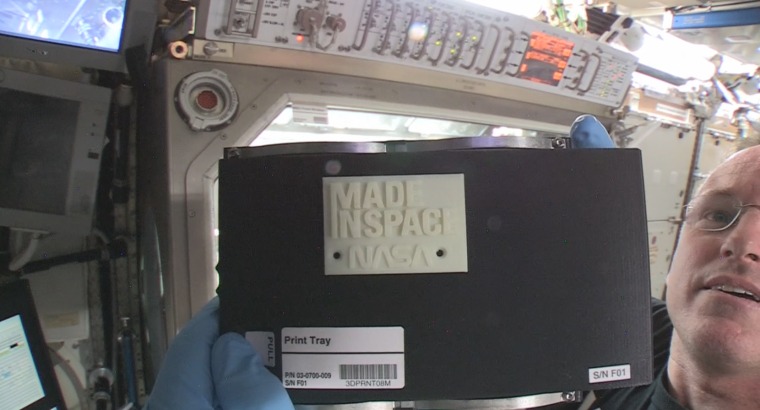After a series of calibration tests, the first 3-D printer to fly to outer space has manufactured its first potentially useful object on the International Space Station: a replacement faceplate for its print head casing.
"An astronaut might be installing it on the printer," said Aaron Kemmer, the chief executive officer of Made In Space, which built the 3-D printer for NASA's use.
The 9.5-inch-wide contraption was delivered to the space station by a robotic SpaceX Dragon cargo ship in September, and NASA astronaut Butch Wilmore set it up inside the station's experimental glovebox a week ago.

Since then, the crew has been printing out plastic test patterns, or "coupons," to check how the machine works in zero gravity. "Everything worked exactly as planned, maybe a little better than planned," Kemmer told NBC News. He said only two calibration passes were needed in advance of the first honest-to-goodness print job, which finished up at 4:28 p.m. ET Monday and was pulled out of the box early Tuesday.
"It's not only the first part printed in space, it's really the first object truly manufactured off planet Earth," Kemmer said. "Where there was not an object before, we essentially 'teleported' an object by sending the bits and having it made on the printer. It's a big milestone, not only for NASA and Made In Space, but for humanity as a whole."
Made In Space's 3-D printer is similar to the earthly variety: A thin filament of ABS plastic is fed through the machine, melted and then extruded through the print head to build up the desired object, layer by thin layer. Over the course of hours, the printer's computer program controls precisely where the squirts of plastic are directed.
On Earth, 3-D printers can make toys and tchotchkes, or plastic pistols and prosthetics. In space, astronauts may someday count on 3-D printers to make tools or spare parts from standard-issue feedstock, rather than having to rely on a stockpile of hardware flown up from Earth at a cost of $10,000 a pound. That capability will be particularly important for trips to Mars — because in deep space, no one can point you to a hardware store.
However, the space environment poses challenges for 3-D printing technology. Does the machine work in weightlessness the way it does in Earth's gravity? Can the plastic be built up into predictable structures? How easy is it to remove the finished part?
NASA reported that the replacement faceplate adhered more strongly to the machine's print tray than anticipated, "which could mean layer bonding is different in microgravity, a question the team will investigate as future parts are printed."
Niki Werkheiser, program manager for the project at NASA's Marshall Space Flight Center, said she and her colleagues are learning a lot, even from the first print.
"As we print more parts we’ll be able to learn whether some of the effects we are seeing are caused by microgravity or just part of the normal fine-tuning process for printing," Werkheiser said in a NASA news release. "When we get the parts back on Earth, we’ll be able to do a more detailed analysis to find out how they compare to parts printed on Earth.”
The next generation
This 3-D printer is primarily a demonstration project. Over the next few months, a variety of items will be printed out in space, including an object designed under the auspices of a contest for students. The lessons learned will be factored into the design of a fuller-featured printer to be sent to the station sometime in the next year or so.
"You can imagine something like the Wright Brothers flight," Kemmer said. "They learned a lot when they flew that first time, then they iterated their design. That's where we're at, in the learning and iterating phase."
Eventually, digital blueprints for printed objects will be customized on Earth, then beamed up to the station for production. Made In Space is also working on a recycling device. "That will close the loop completely," Kemmer said. "You take the [plastic] trash, throw it into a recycler, turn it into feedstock, and print with the recycled feedstock. And when you're done with the part, you can recycle it again."
So will the print head part that was created today someday become the feedstock for another item printed out in space? Not a chance. NASA plans to send the part back down to Earth for analysis — and if Kemmer has anything to say about it, the first object made in space will eventually wind up in a museum.